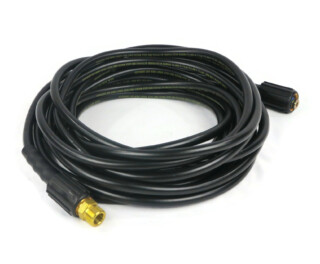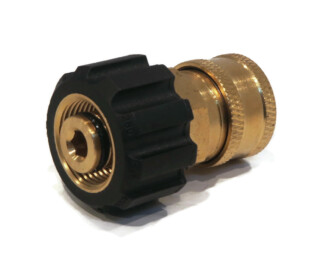
The ROP Shop's Guide to Purchasing a Pressure Washer
Choosing a pressure washer to buy can be overwhelming. A simple search for pressure washers can yield hundreds of results. How do you narrow that down to find the pressure washer that’s right for you?
The ROP Shop’s got your back. We’ll walk you through some of the key features to consider as you weed through the many different options for pressure washers.
(Plus, once you’ve bought your unit, be sure to check out our blogs on pressure washers to help you understand and care for your equipment!)
Key terms and their meanings
Shopping for a pressure washer can quickly land you in a sea of acronyms. PSI, GPM, CU/ECU—what do they all mean? And even if you know what they stand for, do you know how they impact your pressure washer’s performance?

PSI
Let’s start with the term that’s probably the most familiar to the average consumer. PSI stands for pounds per square inch. It’s a common unit of pressure.
The PSI produced by your pressure washer will vary depending on your unloader valve’s settings, your hose, and which tip you use. Essentially, the smaller the opening is that the water is forced out of, the more pressure (or force) you’ll have to work with. Having a high PSI will give you the ability to clear that extra-stubborn dirt and sticky grime.
GPM
GPM stands for gallons per minute. It refers specifically to how much water passes through your pressure washer’s pump in one minute.
Unlike PSI, this number will stay constant on your pressure washer regardless of the settings and attachments you have in place.
If you don’t have an adequate volume of water being pumped through your washer (i.e., it has a low GPM), you’ll be limited in your cleaning abilities.
With a small volume of water exiting the nozzle, you won’t have much pressure unless you use a small tip or hose. However, by doing so you’ll be reducing the area you can clean at a time, so the job will take longer.A lower water flow also means that it will take longer to wash away loose dirt from the surface you’re cleaning.
If you’re a homeowner, consider getting started with a pressure washer that has around 2 to 2.5 GPM.1
CU/ECU
Next is cleaning units or effective cleaning units.
Fortunately, once you understand PSI and GPM, half the battle is already over.
CU or ECU is derived simply from multiplying the PSI by the GPM. This gives you an approximate at-a-glance look at a unit’s overall abilities.
However, you might find yourself in situations where either the PSI or the GPM becomes especially relevant. For example, if you’re attempting to clean tar stains from a surface, having a high PSI becomes crucial.1
This means you’ll want to make sure the individual PSI and GPM values for a given pressure washer make sense for the projects you want to complete instead of only looking at the CU number.
Gas-powered vs. electric pressure washers

There are electric options for lots of outdoor power equipment nowadays, and pressure washers are no exception.
If you anticipate using it for smaller jobs, an electric pressure washer could be the right choice for you. While they tend to be less powerful (with about 1,000-1,500 PSI and 1.5 GPM), you’ll generally find them to be easier to maintain than their gas counterparts as well as cheaper, quieter, and less heavy.2
On the other hand, if you’re interested in a more powerful machine—2,000+ PSI and 2-4 GPM—for heavier-duty jobs, you’ll probably have to go the gas route.2
Think ahead to the types of jobs you expect to do so that you can narrow your options down to the proper type of pressure washer.
Cord and hose length
You probably don’t love the idea of having to move your pressure washer every time you want to take a step. But if you aren’t smart about your pressure washer purchase, you might find yourself being inconvenienced by having a limited range of travel from your unit.
Consumer Reports recommends getting a pressure washer with a hose that’s at least 30 feet long and the same for a power cord if you have an electric unit.
Time spent moving your pressure washer from spot to spot is time you could have spent finishing your job, so make sure you aren’t limiting yourself unnecessarily.
Pressure washer accessories
There are some helpful pressure washer attachments you might want to look out for as you’re searching for the right pressure washer for your needs.
Make sure you carefully check the information on whatever accessory you're looking at to make sure it will work for your specific unit.
Variable spray tips
Your pressure washer may come with these already, but it's good to understand how the spray tips for your nozzle are categorized.
You’ll probably notice that the spray tips have different colors. These indicate the width of the fan-shaped spray that the tip produces. The wider the spray, the less force it will have.

Here’s the spray width associated with each color:
- Red: 0° (this makes the water stream extremely concentrated—use with an abundance of caution)
- Yellow: 15°
- Green: 25°
- White: 40°
- Black: this is generally your low-pressure or soap setting.
Pro tip: we recommend having extra spray tips available whenever you’re working. About half of the time your washer loses pressure, it’s merely because the spray tip wore out. By having extras on hand, you can save yourself a lot of downtime.
You can also purchase adjustable nozzles that give you versatility without having to switch out the tips.
Don’t forget about nozzle orifice size
The size of the hole in your pressure washer’s spray tip impacts the pressure that your unit produces, and it’s important to use the right size for your washer.
A tip with a smaller hole will produce more pressure, but you can harm your washer by using a tip that has too small of an orifice for it. However, if you use too large of a tip, you could wind up with less pressure than you need.
When you’re purchasing spray tips, check the nozzle orifice size against your pressure washer’s specifications (GPM and PSI) to make sure they’re compatible. You can use a chart like this one if it isn’t clear what GPM and PSI are recommended for a set of tips.
Detergent tanks
Want to go the extra mile? Many pressure washers come with detergent tanks so that you can add soap to your cleaning regimen. Just make sure you’re using the proper low-pressure tip whenever you’re siphoning detergent.
Extension lances
Need to clean some hard-to-reach spaces? Give yourself an extra boost of range with an extension lance.
Surface cleaner attachments
A surface cleaner is a dish-shaped attachment with a spray arm underneath that you can connect to your pressure washer’s wand. It can be used to clean large surfaces more efficiently.
For example, if you plan on cleaning driveways or patios with your pressure washer, consider picking up one of these helpful tools.
If you decide this tool is right for you, make sure it’s compatible with the PSI and other specifications of the pressure washer you choose.





Bonus Information
There’s a lot more that could be said about pressure washers. However, we thought we’d wrap up with just a few more things you might find helpful as you get ready to invest in this piece of equipment.
Power washers vs. pressure washers
As you search for the perfect pressure washer, you might see listings for products called “power washers.” Is there a difference?
For most consumers, these terms are pretty interchangeable. However, the two aren’t technically the same. Power washers use heated water, whereas in a pressure washer, the water isn’t heated.
If you do have a pressure washer and not a power washer, only use cold water in it unless your owner’s manual specifically says that you can use heated water. If you put hot water in a unit that isn’t intended for it, you can damage it and cause seals and valves to fail.
Preparing for problems
Troubleshooting
Hopefully you’ll never need the information in this section. But realistically, it will probably be handy to know how to troubleshoot issues you experience with your pressure washer, such as the following:
- Low pressure
- Engine refusing to start
- Pressure washer pulsating
We cover these problems (and more) in our pressure washer troubleshooting guide. We also have a blog post dedicated specifically to troubleshooting issues with your pressure washer’s pump.
Buying a pump replacement
If you ever wind up needing to replace the pump on your pressure washer, you’ll quickly find out it can be a headache with all of the different options available.
Fortunately, this blog covers three steps to finding a replacement pump for your pressure washer. We even include some bonus resources in there, like a video on installing our pressure washer pumps and a fitment chart for the pumps we carry.
The Pressure’s On
With a clearer idea of what you want in a pressure washer, you can make your purchase more confidently. And with your new pressure washer in hand, why not read these tips and tricks for DIY pressure washing to get yourself started?
Don’t forget to come back to The ROP Shop when it’s time to purchase replacement parts. We offer free shipping to the Lower 48 States and a one-year warranty on our products from the date of purchase.

Having trouble using your ROP Shop pressure washer surface cleaner? These tips can help you out.

Thinking about getting a pressure washer? Here are eight advantages to owning a pressure washer to help convince you.

Installing a new pressure washer pump doesn’t have to be a hassle. Let The ROP Shop walk you through it.

Ready to learn how to pressure wash quickly, effectively, and safely? Check out these eleven tips.